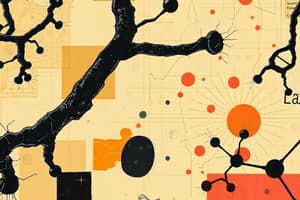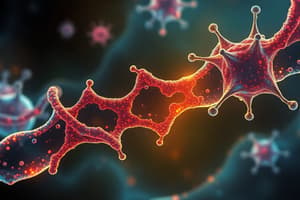Podcast
Questions and Answers
Which of the following statements accurately describes the role of somatic hypermutations in adaptive immunity?
Which of the following statements accurately describes the role of somatic hypermutations in adaptive immunity?
- Somatic hypermutations introduce changes in the heavy chain constant region, creating different antibody isotypes like IgG, IgM, and IgA.
- Somatic hypermutations occur in all B-cell clones, ensuring that a diverse range of antibodies is produced from the beginning.
- Somatic hypermutations are random mutations that introduce variation into the constant region of antibodies, making them more effective at neutralizing pathogens.
- Somatic hypermutations primarily occur in the variable region of antibodies after B-cell activation, leading to increased affinity for antigens. (correct)
Why is the adaptive immune response considered 'adaptive'?
Why is the adaptive immune response considered 'adaptive'?
- The adaptive immune response is constantly evolving to improve its ability to recognize and eliminate pathogens.
- The adaptive immune response is inherited from parents, providing immediate protection against common pathogens.
- The adaptive immune response is activated only after encountering a specific pathogen, allowing for a targeted response. (correct)
- The adaptive immune response quickly adapts to changes in the environment, making it more effective against diverse pathogens.
Which of the following is NOT a mechanism that contributes to antibody diversity?
Which of the following is NOT a mechanism that contributes to antibody diversity?
- Junctional diversity through random nucleotide additions and deletions at gene segment junctions.
- Combinatorial diversity by random recombination of gene segments.
- Mutations in the constant region of antibodies leading to the formation of different antibody isotypes. (correct)
- Somatic hypermutations in antigen-binding sites after B-cell activation by antigen.
Which of the following cells is responsible for engulfing microbes and presenting antigens to lymphocytes in lymph nodes?
Which of the following cells is responsible for engulfing microbes and presenting antigens to lymphocytes in lymph nodes?
How does the structure of an antibody contribute to its ability to recognize and neutralize specific antigens?
How does the structure of an antibody contribute to its ability to recognize and neutralize specific antigens?
What is the primary role of IgD in the adaptive immune response?
What is the primary role of IgD in the adaptive immune response?
What distinguishes the humoral immune response from the cell-mediated immune response?
What distinguishes the humoral immune response from the cell-mediated immune response?
Which of the following statements correctly describes the function of lymph nodes in the adaptive immune response?
Which of the following statements correctly describes the function of lymph nodes in the adaptive immune response?
What is the role of dendritic cells in the initiation of the adaptive immune response?
What is the role of dendritic cells in the initiation of the adaptive immune response?
How does the adaptive immune system contribute to long-term immunity after vaccination?
How does the adaptive immune system contribute to long-term immunity after vaccination?
Which of the following statements accurately describes the role of B-cell receptors (BCRs) in antigen recognition?
Which of the following statements accurately describes the role of B-cell receptors (BCRs) in antigen recognition?
What is the primary function of memory B cells?
What is the primary function of memory B cells?
How does the process of clonal selection contribute to the production of antibodies specific to a particular antigen?
How does the process of clonal selection contribute to the production of antibodies specific to a particular antigen?
Which of the following best describes the role of T-cell receptors (TCRs) in the immune response?
Which of the following best describes the role of T-cell receptors (TCRs) in the immune response?
How does the structure of the B-cell receptor (BCR) differ from the structure of the T-cell receptor (TCR)?
How does the structure of the B-cell receptor (BCR) differ from the structure of the T-cell receptor (TCR)?
What is the main difference between plasma cells and memory B cells?
What is the main difference between plasma cells and memory B cells?
Which of the following is the correct sequence of events in B-cell activation?
Which of the following is the correct sequence of events in B-cell activation?
How does the immune system generate a diverse repertoire of antibodies?
How does the immune system generate a diverse repertoire of antibodies?
What is the primary role of the thymus in the immune system?
What is the primary role of the thymus in the immune system?
How do vaccines work?
How do vaccines work?
Flashcards
B cells
B cells
White blood cells that produce antibodies.
Antibody diversity
Antibody diversity
Variety of antibodies produced through genetic rearrangement.
Variable region
Variable region
Part of an antibody that differs between antibodies.
Constant region
Constant region
Signup and view all the flashcards
Combinatorial diversity
Combinatorial diversity
Signup and view all the flashcards
Junctional diversity
Junctional diversity
Signup and view all the flashcards
Somatic hypermutation
Somatic hypermutation
Signup and view all the flashcards
Humoral response
Humoral response
Signup and view all the flashcards
Cell-mediated response
Cell-mediated response
Signup and view all the flashcards
Dendritic cells
Dendritic cells
Signup and view all the flashcards
Native T cells
Native T cells
Signup and view all the flashcards
T cell function
T cell function
Signup and view all the flashcards
B cell receptors (BCR)
B cell receptors (BCR)
Signup and view all the flashcards
T cell receptors (TCR)
T cell receptors (TCR)
Signup and view all the flashcards
Clonal selection
Clonal selection
Signup and view all the flashcards
Plasma cells
Plasma cells
Signup and view all the flashcards
Memory B cells
Memory B cells
Signup and view all the flashcards
Antibody classes
Antibody classes
Signup and view all the flashcards
Vaccine function
Vaccine function
Signup and view all the flashcards
Study Notes
Antibody Structure and Generation
- Antibodies are produced by B cells, originating in the bone marrow.
- Each B cell clone produces a unique antibody.
- The antibody structure has a variable region (different for each antibody) and a constant region (remains the same).
- IgD is a class of antibodies that acts as B cell receptors (BCR).
- Antibody genes are located in segments on chromosomes, including V (variable), D (diversity), and J (joining) gene segments (Heavy chains only have D) with a total of 30-45 variable segments.
- B cells generate diverse antibodies by combining these gene segments.
- Recombination of V, D, and J segments (heavy chain) and V and J segments (light chain) creates different antibody combinations.
- Random mutations at junctions of gene segment joins contribute to diversity.
- "Somatic hypermutation" is a process of continuous mutations in antibody variable regions, occurring after antigen binding, which increases antibody affinity for the antigen.
Adaptive Immune System and Antibody Production mechanisms
- The adaptive immune system is not inherited but is created anew.
- B cells, differentiating in the bone marrow, create their unique antibody genes through the rearrangement of variable region segments.
- Antigen binding to a B cell triggers massive proliferation of that B cell clone - clonal selection.
- Antibodies are crucial for the humoral immune response.
- Plasma cells are differentiated activated B cells that produce and secrete large amounts of antibodies.
- Memory B cells develop from the activated clone of a B cell, providing long-lasting immunity or memory to the system.
- These memory cells rapidly respond to subsequent encounters with the same antigen.
Adaptive Immunity Overview
- The adaptive immune system provides immunological "memory," enabling quicker responses to future encounters with a given antigen (e.g., vaccinations)
- It involves two main types of responses: humoral (antibodies) and cell-mediated.
- In response to injury, macrophages, neutrophils, and complement proteins, assist the immune system.
- Dendritic cells (DCs) are vital antigen-presenting cells (APCs) located in external-facing tissues (e.g., skin).
- DCs have long cytoplasmic projections called dendrites, crucial for pathogen recognition.
- DCs become activated through pathogen recognition receptors (PRR) binding to antigens, leading to migration to lymph nodes to present antigens.
Lymphatic System and Antigen Presentation
- The lymphatic system's lymph fluid circulates throughout the body, aided by muscle movement.
- Lymph nodes are crucial for antigen presentation.
- Dendritic cells (DCs) and macrophages present antigens to B cells and T cells in lymph nodes, while soluble antigens reach the spleen directly.
- The process of antigen presentation involves:
- External barrier breach.
- Microbe entry.
- Antigen engulfment and display by dendritic cell (DC).
- Antigen presentation in lymph nodes.
- B cell activation following antigen binding.
- T cell activation following antigen encounter.
B Cells and T Cells: Lymphocytes
- B cells produce and secrete antibodies, essential for humoral immunity.
- B cells mature in the bone marrow.
- T cells detect and kill infected cells, crucial for cell-mediated immunity.
- T cells mature in the thymus.
- B cells and T cells originate from stem cells in the bone marrow.
- Both migrate to lymph nodes, waiting for activation.
B Cell Receptors (BCR)
- The B cell receptor (BCR) is a membrane-bound antibody (IgD).
- BCRs have two identical heavy chains and two identical light chains, linked by disulfide bridges.
- Each BCR has two antigen-binding sites located in the variable regions of the light and heavy chains.
- BCRs can recognize a wide array of antigens, including carbohydrates, lipids, DNA, and proteins.
T Cell Receptors (TCR)
- The T cell receptor (TCR) is similar to antibodies, but has only one binding site.
- TCRs recognize peptide antigens presented by other cells.
- TCRs are generated using the same gene rearrangement processes as antibodies.
- TCRs consist of one alpha chain and one beta chain linked by disulfide bridges. (A single binding site as opposed to 2 binding sites)
B Cell Activation, Clonal Selection, and Antibody Secretion
- When antigens reach lymph nodes, naive B cells recognize them via BCRs.
- B cells that specifically bind to an antigen are activated and replicate, creating clones.
- Activated B cells differentiate into plasma cells or memory cells.
- Plasma cells produce large quantities of antibodies specific to the original antigen, typically peaking about 5-6 days after infection.
- Some plasma cells remain in the bone marrow, producing low levels of antibodies for a longer duration.
- Memory B cells retain the same membrane-bound antibody as the original activated B cell. They provide long-term immunity to the antigen, quickly responding with a strong immune response upon subsequent exposure.
- Vaccines utilize this principle by triggering the production of memory cells, preparing the body for a rapid response to a real infection, if encountered later.
Studying That Suits You
Use AI to generate personalized quizzes and flashcards to suit your learning preferences.
![Lecture 05: antibodies and adaptive immunity [MCQ 2]](https://assets.quizgecko.com/cdn-cgi/image/width=800,height=300,fit=crop,quality=75,format=webp/quiz/a3e4e8ef7006277333e79cce5068a4e0.jpg)



